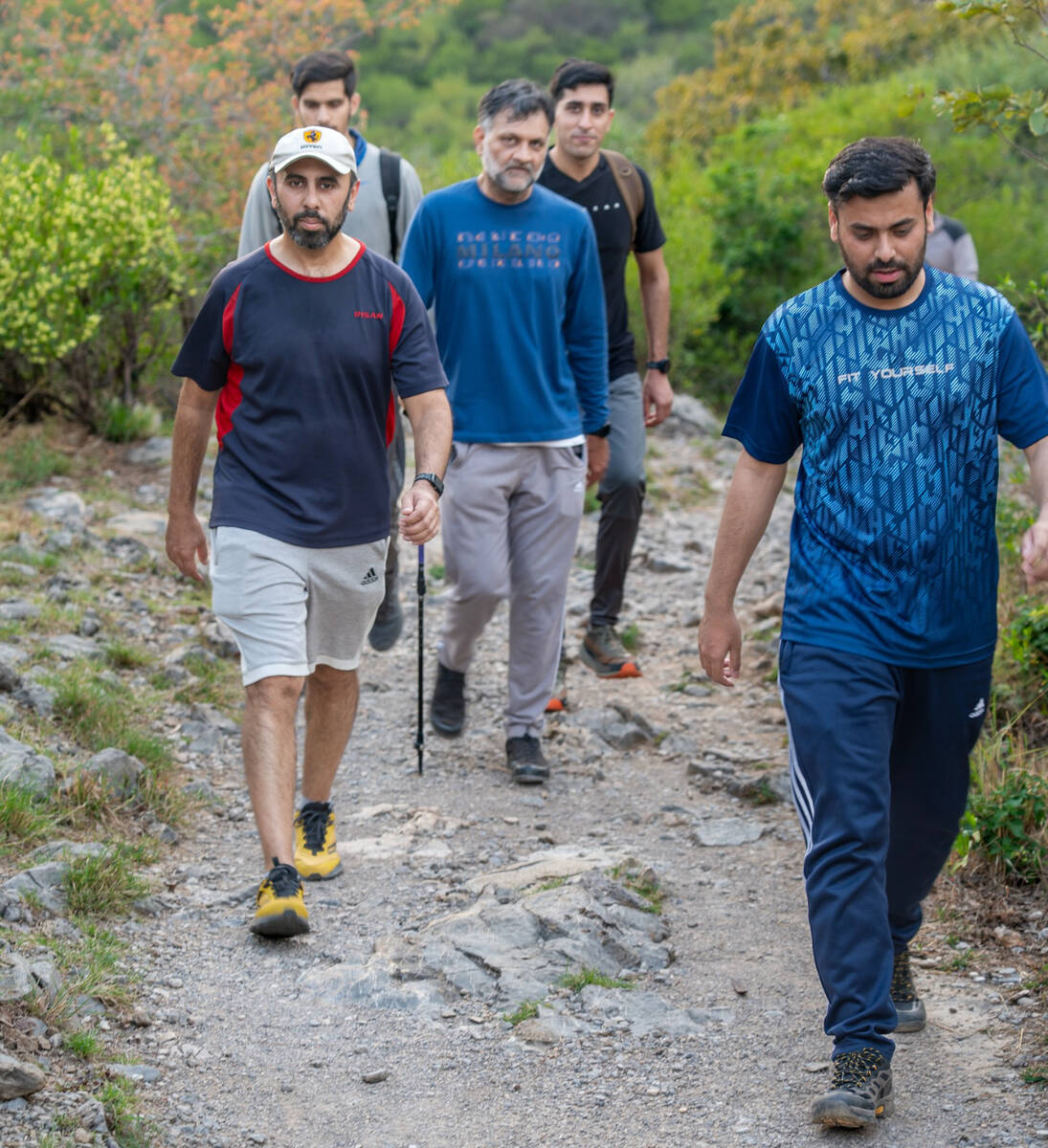CAPE TOWN: Dutch actress and adventurer Manon “Tractor Girl” Ossevoort arrived at the South Pole Tuesday after chugging along on a tractor from Europe through Africa and across the frozen wastes of Antarctica.
“It’s quite emotional, I’m very happy,” Ossevoort told AFP by satellite telephone shortly after arriving at the Pole and fulfilling a decade-long dream.
“It feels quite magical really, to have made this happen and arrived here!“
The ebullient new mother of a 10-month-old baby said the the 16-day, 2,500 km trip across the largest single mass of ice on earth from Russia’s Novo base to the Pole had been tough.
Driving the huge red Massey Ferguson tractor over the rugged, icy landscape at an average speed of about 10 km an hour was “like rodeo riding.”
Ossevoort said the worst part of the trip was “the day that I was driving for hours and hours and could not go faster than between 0.5 and five km per hour.”
“I really was worried then that the expedition could come to a halt if conditions would get just a little bit worse.”
Now she has to do the return trip.
It will be a race to make it home to the Netherlands for Christmas but the “return journey to the base will be faster because the tracks of the tractor will be frozen up and it will be easier to drive.” Ossevoort began her trip in 2005, taking four years to drive from her home village in the Netherlands to Cape Town at the southern tip of Africa — and then missed the boat that was due to take her to Antarctica for the final leg due to delays.
Frustrated, the former theater actress spent the next four years back in the Netherlands, writing a book, working as a motivational speaker and desperately trying to get back on a tractor.
Dutch adventurer reaches South Pole on tractor
Dutch adventurer reaches South Pole on tractor

Film ‘Warfare’ immerses viewers in real-time Iraq War mission

- “Warfare” sees the young men taking up positions in a residential building in the dark of night
LONDON: New A24 movie “Warfare” places audiences among a platoon of US Navy SEALs as they battle insurgents during the Iraq War.
Written and directed by combat veteran Ray Mendoza and filmmaker Alex Garland, the movie is a real-time re-enactment of a 2006 surveillance operation gone awry and based entirely on the memories of Mendoza and the soldiers who took part in it.
“Warfare” follows Garland’s 2024 film “Civil War,” which Mendoza worked on as a military supervisor, and features an ensemble cast of top talent including Cosmo Jarvis, Will Poulter, Charles Melton, Joseph Quinn, Kit Connor and D’Pharaoh Woon-A-Tai.
It pays tribute to wounded sniper Elliott Miller, played by Jarvis, whose recollections of the events are sparse.
“I wanted to make it for Elliott,” Mendoza said at the film’s London premiere on Tuesday. “He doesn’t recall what happened. Over the years he’s asked a lot of questions. I’ve been in this industry for 15 years now, and it’s kind of a goal, a journey, for me to acquire all the tools and skills I needed along the way to make it.”
The filmmakers set a rule to “not invent or heighten anything” and recount the events as accurately as possible.
“What films usually do is they find a way to dramatize, and that sometimes means romanticize combat and conflict and to be inaccurate. We tried to strip all of that out and present war in this instance, as it was. That was our sole intention,” Garland said.
“Warfare” sees the young men taking up positions in a residential building in the dark of night. It depicts their close bond and the chaos that ensues when they come under fire and try to evacuate wounded soldiers.
For the cast, portraying real people and recreating the events in Ramadi, came with responsibility.
“We had to try and do the story, what happened, justice and try to do these characters justice,” said Connor, who plays gunner Tommy.
“Warfare” was shot outside London over five weeks in early 2024. In preparation for its extended takes and carefully choreographed scenes, the cast took part in an intensive three-week boot camp.
“That included weapons handling, strategy, tactics, some of the language that is unique to SEALs and the military. We learned radio communications, first aid, some navigational stuff, and then went out on a few exercises as a team and put it into practice,” said Poulter, who plays an officer in charge of the operation.
Although immersing audiences in warfare, the movie is rooted in humanity, said Michael Gandolfini, who plays Lt. Macdonald.
“It’s about human beings and it’s about consequences of human beings doing these things to other humans. You walk out, I believe, feeling immense pain but immense humanity.”
“Warfare” begins its global theatrical rollout on April 10.
A fire at a New York cat sanctuary kills its founder and dozens of cats

- The body of founder Christopher Arsenault, 65, was found in a back room, officials said
- An estimated 150 cats are believed to have survived at the facility
NEW YORK: A fire burned down a Long Island cat shelter, killing its founder, who lived there, and at least 59 of the felines he rescued, authorities said.
The fire at the Happy Cat Sanctuary in the hamlet of Medford was reported shortly after 7 a.m. Monday. The cause is under investigation.
The body of founder Christopher Arsenault, 65, was found in a back room, officials said.
“He appeared to be a very caring person,” said Roy Gross, chief of the Suffolk County SPCA. “His life was about the cats.”
An estimated 150 cats are believed to have survived at the facility, which also included outdoor buildings, Gross said. Some of the surviving animals suffered burns and smoke inhalation. The SPCA and other animal rescue groups were working together to arrange care for them.
Arsenault founded Happy Cat in 2006 after the death of his 24-year-old son, Eric, in a motorcycle accident, according to the sanctuary’s website. Arsenault described finding his calling when he came across a colony of 30 sick kittens and nursed them back to health.
At the time of the fire, he was planning to move the sanctuary from Long Island to a farm upstate, Gross said.
“Unfortunately, this disaster happened and now he’s gone,” Gross said. “Right now it’s in the early stages of trying to put all of this together to get these animals cared for.”
A Venus flytrap wasp? Scientists uncover an ancient insect preserved in amber that snatched its prey
A Venus flytrap wasp? Scientists uncover an ancient insect preserved in amber that snatched its prey

- Scientists uncovered over a dozen female wasps preserved in 99-million-year-old amber from the Kachin region in northern Myanmar
- It’s a playbook adapted by many parasitic wasps, including modern-day cuckoo and bethylid wasps, to exploit insects
NEW YORK: An ancient wasp may have zipped among the dinosaurs, with a body like a Venus flytrap to seize and snatch its prey, a new study says.
The parasitic wasp’s abdomen boasts a set of flappy paddles lined with thin bristles, resembling “a small bear trap attached to the end of it,” said study co-author Lars Vilhelmsen from the Natural History Museum of Denmark.
Scientists uncovered over a dozen female wasps preserved in 99-million-year-old amber from the Kachin region in northern Myanmar. The wasp’s flaps and teeth-like hairs resemble the structure of the carnivorous Venus flytrap plant, which snaps shut to digest unsuspecting insects. But the design of the wasp’s getup made scientists think its trap was designed to cushion, not crush.
Instead, researchers suggested the flytrap-like structure was used to hold a wriggly insect still while the wasp laid an egg, depositing a baby wasp to feed on and drain its new host.
It’s a playbook adapted by many parasitic wasps, including modern-day cuckoo and bethylid wasps, to exploit insects. But no known wasp or any other insect does so with bizarre flaps quite like this one.
“I’ve seen a lot of strange insects, but this has to be one of the most peculiar-looking ones I’ve seen in a while,” said entomologist Lynn Kimsey from the University of California, Davis, who was not involved with the research.
Scientists named the new wasp Sirenobethylus charybdis, partly for the sea monster from Greek mythology that stirred up wild whirlpools by swallowing and expelling water.
The new study was published in the journal BMC Biology and included researchers from Capital Normal University and the Beijing Xiachong Amber Museum in China.
It’s unclear when the wasp went extinct. Studying unusual insects like this one can help scientists understand what insects are capable of and how different they can be.
“We tend to think that the cool things are only found today,” said Gabriel Melo, a wasp expert at the Federal University of Paraná in Brazil, who had no role in the study. “But when we have this opportunity, we see that many really exceptional, odd things already happened.”
Fitness enthusiasts challenge themselves with pre-iftar hikes in Pakistani capital

- Hikers set out hour before sunset, break fast on trails on Margalla Hills National Park
- Participants say pre-iftar hikes help boost fat burning, maintain weight in Ramadan
ISLAMABAD: Zarnab Tahir struggled to catch her breath as the steep incline of the hiking trail at Islamabad’s picturesque Margalla Hills tested her endurance. Hiking can put people through physical exertion, especially when they do it on an empty stomach.
An hour before the sun sets and the call to prayer blares out from various mosques located in Pakistan’s capital city, a group of fitness enthusiasts take to the hiking trails in Margalla Hills National Park.

Islamabad Run With Us — IRU — which describes itself as Pakistan’s “pioneering running community,” is behind the pre-iftar hiking initiative.
“When you engage in pre-iftar (physical) activities during Ramadan, it gives you extra energy, an extra boost,” Qasim Naz, who founded IRU in 2016, told Arab News on hiking trail number three.

“And when someone joins in on an activity once or twice, they figure out it’s not that hard and they can sustain it comfortably.”
Naz stresses that staying active during the holy month is essential. The IRU organizes five activities a week, which include two runs and three hikes.

“Either we can maintain our weight, or if our goal is weight loss, we can achieve it by being in a calorie deficit while eating a healthy diet and exercising,” Naz explained.
Tahir, 22, meanwhile, said that she was committed to reaching the top of hiking trail before sunset. This was the second time she was hiking with IRU.

She agreed with Naz that group activities are “much easier” to sustain.
“I think it is important to go at your own pace and it’s so much easier with the group,” Tahir, a content creator, told Arab News.

“If you go alone, it’s kind of more difficult and you are, like, really slow but if you go with the group you can maintain that pace and I think it’s much easier that way.”
Mahwish Ashraf, a journalist associated with a foreign diplomatic mission in Islamabad, shared how she struggled the first time that she went on a pre-iftar hike with IRU.
“The first time I was hiking, I returned from in between, I couldn’t complete it,” she admitted. “So, this is my second time hiking with the IRU, and gladly, I’m at the main point, the meeting point.”
Eraj Khan, a commercial specialist visiting from Australia to spend Ramadan with his family, said pre-iftar hikes give one “lots of energy.”
“For fat burning, it’s a great activity,” Khan said. “Especially because the last two hours of fasting are the hardest, most people feel really hungry. But so far, I’m loving it.”
As the clock continued to tick and evening settled in, the hikers began to pick up their pace. For Tahir, reaching the top of the trail before sunset was a victory in itself.
She had pushed past exhaustion, embraced the challenge and proved to herself that she was capable of more than she thought she could achieve.
And according to her, hiking with the group made all the difference.
“The energy of the group keeps you going,” she said. “Even when you feel like stopping, you see everyone else moving forward, and you push through.”
Arctic sea ice hits lowest peak in satellite record, says US agency

- Arctic sea ice forms and expands during the dark, frigid northern winter, reaching its seasonal high point in March
- In recent years, less new ice has formed, and the accumulation of multi-year ice has steadily declined
WASHINGTON: This year’s Arctic Sea ice peak is the lowest in the 47-year satellite record, according to data released by the US National Snow and Ice Data Center (NSIDC) on Thursday, as the planet continues to swelter under the mounting effects of human-driven climate change.
Arctic sea ice forms and expands during the dark, frigid northern winter, reaching its seasonal high point in March. But in recent years, less new ice has formed, and the accumulation of multi-year ice has steadily declined.
The maximum sea ice level for 2025 was likely reached on March 22, measuring 14.33 million square kilometers (5.53 million square miles) — below the previous low of 14.41 million square kilometers set in 2017.
“This new record low is yet another indicator of how Arctic sea ice has fundamentally changed from earlier decades,” said NSIDC senior research scientist Walt Meier in a statement.
“But even more importantly than the record low is that this year adds yet another data point to the continuing long-term loss of Arctic sea ice in all seasons.”
The Arctic record follows a near-record-low summer minimum in the Antarctic, where seasons are reversed.
The 2025 Antarctic sea ice minimum, reached on March 1, was just 1.98 million square kilometers, tying for the second-lowest annual minimum in the satellite record, alongside 2022 and 2024.
Combined Arctic and Antarctic sea ice cover — frozen ocean water that floats on the surface — plunged to a record low in mid-February, more than a million square miles below the pre-2010 average. That is an area larger than the entire country of Algeria.
“We’re going to come into this next summer season with less ice to begin with,” said Linette Boisvert, an ice scientist at NASA’s Goddard Space Flight Center in Greenbelt, Maryland. “It doesn’t bode well for the future.”
US scientists primarily monitor sea ice using satellites from the Defense Meteorological Satellite Program (DMSP), which detect Earth’s microwave radiation.
Because open water and sea ice emit microwave energy differently, the contrast allows sea ice to stand out clearly in satellite imagery — even through cloud cover, which obscures traditional optical sensors.
DMSP data is supplemented with historical records, including early observations from the Nimbus-7 satellite, which operated from 1978 to 1985.
While floating sea ice does not directly raise sea levels, its disappearance sets off a cascade of climate consequences, altering weather patterns, disrupting ocean currents, and threatening ecosystems and human communities.
As reflective ice gives way to the darker ocean, more solar energy is absorbed rather than reflected back into space, accelerating both ice melt and global warming.
Shrinking Arctic ice is also reshaping geopolitics, opening new shipping lanes and drawing geopolitical interest. Since taking office this year, US President Donald Trump has said his country must control Greenland, a Danish autonomous territory rich in mineral resources.
The loss of polar ice spells disaster for numerous species, robbing polar bears, seals, and penguins of crucial habitat used for shelter, hunting, and breeding.
Last year was the hottest on record, and the trend continues: 2025 began with the warmest January ever recorded, followed by the third-warmest February.
NOAA predicts that La Nina weather conditions, which tend to cool global temperatures, are likely to give way to neutral conditions that would persist over the Northern Hemisphere summer.
Polar regions are especially vulnerable to global warming, heating several times faster than the global average.
Since mid-2023, only July 2024 fell below 1.5 degrees Celsius of warming, raising concerns that the Paris Agreement’s goal of limiting long-term warming to 1.5C may be slipping out of reach.



















